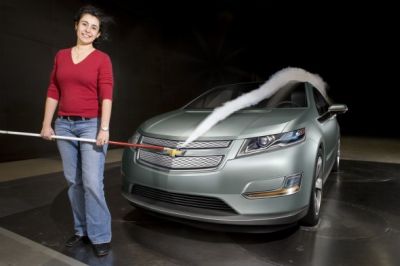
Nina Tortosa, the Chevrolet Volt aerodynamicist, collaborated with the Volt designers to shape the car and make it one of General Motors’ most aerodynamic vehicles ever produced.
(Photo credit: Chevrolet Volt Aerodynamicist Nina Tortosa worked with Volt designers to shape the car, making it one of the most aerodynamic vehicles GM has ever produced. X11CH_VT019 (7/16/2010)
In a 2010 interview with a Career Communications Group magazine, Nina explained the significance of aerodynamics in reducing drag, enhancing fuel economy, and extending the vehicle’s range.
Nina’s work on the Chevy Volt was her small contribution to advancing the automotive industry. She has a passion for aerodynamics, stemming from her childhood dream of becoming an astronaut.
Born in Barcelona, Spain, and raised in Minneapolis, Minnesota, Nina speaks fluent Spanish and German. She has a pilot’s license and enjoys windsurfing and other outdoor activities.
Thanks to Nina’s hard work, the Volt was a breakthrough in fuel economy, setting a new standard for eco-friendly cars of our time, with a flex fuel-powered engine generator that extends its range to more than 300 miles.
She revealed that 90 percent of the drag comes from pressure drag, which is caused by high pressure from the front of the vehicle and low pressure from the back, creating a force that slows down the vehicle.
The 2018 Volt offered up to 53 pure electric miles and 420 miles with a full charge and full gas tank, making it a reliable and efficient car for daily use.
As the performance engineer in aerodynamics, Nina spent her time in the wind tunnel, testing the Volt’s design and ensuring its aerodynamic efficiency.
She worked with a whole studio of designers and engineers from around the world, resulting in the most eye-catching and eco-friendly car of our time.
In other news, the electric car market is expected to grow, comprising 55 percent of global recent car sales by 2040, and replacing 7 percent of gas and diesel consumption.
It is interesting to note that General Motors previously manufactured the EV1, a battery-electric vehicle that was eventually taken off the road in 2003 due to the unavailability of parts to repair them.
Electric vehicles had a significant problem – they had limited range, running only 126 miles between charges, and there were few places to recharge them.
To make matters worse, recharging took several hours, while refilling a gas tank took only 15 minutes. These were major obstacles that needed to be overcome.
Fast forward to 2010, and the Chevrolet Volt was the first mass-produced vehicle designed to drive up to 40 miles on a single battery charge.
It is an electric car that creates its electricity by plugging it in overnight, allowing it to run on a pure electric charge for up to 40 miles without any emissions.
After that, the Volt can still keep going, even if you can’t plug it in, thanks to a range-extending gas generator that produces enough energy for hundreds of miles on a single gas tank.
When GM engineers designed the Volt, they wanted to create a battery range that would allow many people to drive without gas for most of the time.
They found that more than 75 percent of people commute 40 miles a day or less, and developed Volt to meet most people’s basic driving needs while preserving their ability to drive on a pure electric charge most of the time.
A standard gasoline-powered internal combustion engine will kick in when the battery runs down. So, let’s say you have a fully charged battery.
Depending on the weather, the electrical features turned on, and how you drive, you can drive up to 40 miles on the electricity stored in the battery, which is gas- and emissions-free.
After that, the gas-powered, range-extending generator automatically kicks in to provide electrical power, and Volt can go for several hundred additional miles until you can plug it in or fill it up again.
The electric Chevrolet Volt was the first mass-produced vehicle to drive up to 40 miles on a single battery charge without using any gasoline or producing emissions.
Given that nearly 8 out of 10 Americans commute fewer than 40 miles per day, this is a significant milestone.
The U.S. Army Corps of Engineers has been tasked with…
Brown and Caldwell, a leading environmental engineering and construction firm,…
Humboldt State University, one of four campuses within the California…